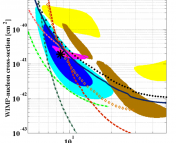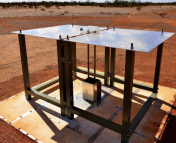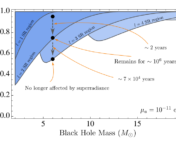The Undergraduate Research series is where we feature the research that you’re doing. If you are an undergraduate that took part in an REU or similar astro research project and would like to share this on Astrobites, please check out our submission page for more details. We would also love to hear about your more general research experience!

Lucia Volkova
Northeastern Illinois University
This guest post was written by Lucia Volkova. She is a recent graduate of Northeastern Illinois University. She obtained her Bachelor’s in physics and plans to complete her Master’s and Doctorate degrees in astrophysics next. This research was carried out to fulfill honors requirements and done under the supervision of Dr. Orin Harris.
Bubble chambers are one of several detector types that particle physicists use to search for the as-yet-undetected dark matter. The PICO collaboration – a portmanteau formed from the merger of the similar PICASSO (Project In Canada to Search for Supersymmetric Objects) and COUPP (Chicagoland Observatory for Underground Particle Physics) experiments – runs one such bubble detector using superheated liquid fluorocarbons (with and without iodine). Various modes of measurement are used to collect data when a bubble is detected within the fluid: cameras at different angles take sequential images, the liquid pressure is monitored, and piezoelectric sensors around the chamber are used to capture the sound waves and convert them to electric currents.
Bubbles that form along chamber walls exhibit different behavior than those which nucleate (or form) in the bulk of the target liquid due to shape distortions from the wall boundary; they do not grow symmetrically and have characteristic “tails” unlike normal, spherical bubbles. In previous analyses when searching for dark matter, these wall events have been excluded from the data set to control for this differing behavior using information available from images or pressure-rise data. Seventy-nine events (bubbles) of dark matter search data acquired by the PICO-60 bubble chamber in 2016 were visually categorized as wall or bulk events and analyzed acoustically. With the help of the piezoelectric sensors and filtering software, waveform profiles can be created for each bubble, exploring properties such as power at varying frequencies and overall wave shape. The goal of this research was to find any parameters that could reliably distinguish wall events from bulk events for a cleaner analysis.

Wall events were found to significantly differ from bulk events using multiple acoustic parameters including overall loudness. Acoustic data was found to be a promising indicator of event type and yielded an efficient and reliable fiducial cut. In particle physics, the fiducial volume is the portion of the target liquid from which data will be included and is always smaller than the total detector volume. Using these cuts, 100% specificity was achieved, meaning that zero wall events were incorrectly characterized as bulk events (and, therefore, erroneously included in the dark matter search data). Up to 92% efficiency was achieved, meaning no more than 8% of the bulk events were incorrectly characterized as wall events (and, therefore, erroneously left out of the dark matter search data). These results suggest that a larger volume of target fluid can be considered in future analyses. Having multiple modes of observation is also critical in validating existing methods used to determine the target fluid volume. The preliminary results indicate that future analyses would likely showcase several percent more efficient fiducialization by leveraging acoustic parameters similar to those investigated here. This would allow for a larger data set per detector run time, perhaps resulting in earlier detection of dark matter or improved constraints on possible dark matter particle characteristics such as mass.
Astrobite edited by: Ellis Avallone




